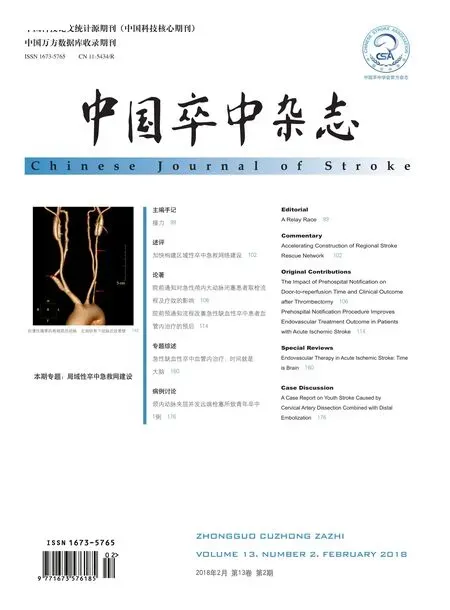C型凝集素受体参与出血性卒中炎性脑损伤的作用机制及前景展望
刘晓莹,邹伟,于学平
中国因卒中死亡的患者每年有160万[1-2],其中有18%~47%是出血性卒中患者[3]。出血性卒中即非外伤性脑出血,是卒中的一个分型,其病理损害主要包括原发性脑损伤和继发性脑损伤。原发性脑损伤是指出血后的占位效应,颅内容积增大、内环境遭到破坏而导致的颅内压升高等;继发性脑损伤是指由初级损伤诱发的血液循环障碍、代谢紊乱、脑水肿、血液分解产物释放等[4-5]。目前仍无有效的治疗方法改善出血性卒中高发病率和高死亡率的现状。越来越多的证据表明先天性免疫应答和炎症损伤参与了脑出血后神经功能损伤的病理过程[4,6-9]。巨噬细胞诱导的C型凝集素受体(macrophage-inducible C-type lectin,Mincle)会结合坏死细胞中释放的SAP130配体而激发下游反应[10-11]。在坏死或外界刺激下,Mincle使下游脾酪氨酸激酶(spleen tyrosine kinase,Syk)磷酸化,促使NF-κB通路激活,产生促炎因子,并促进中性粒细胞浸润[11-12]。在包括缺血性卒中和脑外伤在内的中枢神经系统疾病中,Mincle/Syk通路已被证实作为激发点参与炎症反应的发生[13-14]。最新研究表明,抑制Mince/Syk通路有助于控制蛛网膜下腔出血后早期的炎性脑损伤[10]。本文就Mincle/Syk信号转导通路研究进展进行综述,以期为研究出血性卒中发病机制提供新思路,为治疗出血性卒中提供新靶点。
1 Mincle的结构与分布
Mincle也叫作CLEC4E,连同Dectin-1、Dectin-2、MCL、MMR及DC-SIGN都隶属于C型凝集素受体(C-type lectin receptor,CLR)家族[15-17],是由Makoto Matsumoto等[18]于1999年在小鼠腹腔巨噬细胞中发现的。目前对Mincle受体结构的研究尚不完善,Makoto Matsumoto等[18]指出它是一种含有219个氨基酸的Ⅱ型跨膜蛋白,其中包括含氨基端的胞内区,一段跨膜区和含有羧基端的胞外区。Mincle受体在人类基因组中由于胞外区缺乏多态性,而使其生物学活性处于相对保守状态[19]。Mincle受体主要在髓系细胞中表达,特别是某些抗原提呈细胞如巨噬细胞、树突状细胞,在B细胞及大脑的小胶质细胞中也可发现受体的表达[19-21]。Yue He等[10]最新的实验结果表明,Mincle在蛛网膜下腔出血(Subarachnoid Hemorrhage,SAH)大鼠脑组织的小神经胶质细胞和神经元中均有表达,但在星形细胞中无表达。Christine Ribbing等[22]发现肥大细胞表面也是Mincle受体表达分布的区域。
2 Mincle与炎症反应
Mincle已被广泛证实,作为致病刺激的受体,随之引发了先天的促炎症反应[23]。然而,最新的研究指出,Mincle不单纯诱导促炎症反应,还是一种免疫调节剂,它参与并促进了抗炎细胞因子的表达,并对抗调节促炎症信号通路[24]。实验显示,白细胞介素10(interleukin-10,IL-10)分泌增多可增强老鼠对病原菌的易感性[25]。而Mincle在巨噬细胞上的IL-10表达中起重要作用[26-27]。除了诱导抗炎细胞因子分泌外,Mincle最近还被发现关系到促炎信号的下行调节。Mincle基因敲除小鼠腹腔感染真菌后炎性细胞因子及中性粒细胞募集均较少[28]。Mincle可与结核分枝杆菌结合,激活巨噬细胞产生炎性因子和一氧化碳。此外机体在受到辐射等刺激时,会引发胸腺细胞死亡和中性粒细胞浸润,此时Mincle将发挥其免疫监视的作用,减少炎性浸润造成的组织细胞损伤,有利于后期恢复。还有学者在类风湿性关节炎患者血清中检测到Mincle信使核糖核酸(ribonucleic acid,RNA)水平升高[29]。可见Mincle广泛参与多种免疫反应及炎症反应过程,而炎症反应正是出血性卒中后脑水肿加重的诱因,可引起严重的继发性脑损伤。由此可见抑制Mincle及其相关的炎性反应通路,可为防止出血性卒中炎性脑损伤、降低脑水肿造成的风险提供新思路。
3 Mincle/Syk信号转导通路与出血性卒中
CLR信号通过Syk-Card9通路生成一个独特的转录激活程序。Syk与CLR胞内磷酸化ITAM基序或衔接蛋白相绑定以启动信号转导是通过以下几种模块完成的:①PLCγ2,在Dectin-1激活后被磷酸化诱发Ca2+流出,继而通过激活钙调磷酸酶触发了NFAT转录因子的核外露[30-31]。PLCγ2-DC无法通过激活MAPK来分泌炎性细胞因子和指导T细胞Th1/Th17极化[30,32]。②Card9-Bcl10-Malt1复合体对由Dectin-1配体凝胶多糖所诱发的基因表达及TDM和TDB至关重要[33-34]。Card9-Bcl10-Malt1导致NF-κB激活而不需要激活MAPKs ERK1/2、JNK和p38[33,35-36]。同时有证据表明PLCγ将Syk与Card9相链接[30]。③Dectin-1和Syk激活的同时也激活了Raf-1受体,导致RelA磷酸化,从而介导了NF-kb调解基因的表达[37]。SAP130作为Mincle的一种结合蛋白是U2 snRNP的一个组件,固定存在于活细胞的细胞核中[11,38],当组织损伤、细胞坏死时,SAP130将被释放出来,作为配体与Mincle受体相结合,使下游Syk磷酸化,进而激活Card9依赖的级联信号。其中Card9含量的多少与免疫反应效果直接相关,而Card9-Bcl10-Malt1复合体在NF-κB途径的激活中扮演至关重要的角色。一旦NF-κB信号通路被激活,包括肿瘤坏死因子α、IL-6等在内的相关炎性因子将呈现高表达。已有研究证实NF-κB参与了出血性卒中的炎性反应过程[39],而关于其上游的Mincle的研究还比较少见。
4 Mincle参与神经系统疾病的发展
De Rivero Vaccari Juan Carlos等[13]实验发现,脑外伤后Mincle在大脑皮层神经元细胞中被SAP130激活,并产生肿瘤坏死因子(tumor necrosis factor,TNF)。外伤后脑组织及脑脊液中Mincle表达增多,抑制Mincle通路后,TNF表达减少。Thiruma V Arumugam等[40]提出Mincle/Syk信号转导通路参与了缺血性卒中小鼠的病理生理过程。也有实验表明[14],Mincle在人和鼠缺血脑组织中的免疫细胞及非免疫细胞中均有表达;Mincle、Syk参与的先天免疫系统在脑缺血及再灌注的病理过程中起关键作用。Yue He等[10]实验发现,Mincle在小胶质细胞及神经元中有表达;SAH后Mincle/Syk信号通路被激活,炎性因子及MPO表达增多,抑制其通路激活则相应指标表达降低,并可减轻神经功能损伤程度。Yi Xie等[41]在此基础上,以Mincle/Syk为靶点,利用人白蛋白干预SAH大鼠,取得了很好的抑制免疫及抗炎的效果。
5 Mincle参与出血性卒中治疗的前景展望
Mincle作为CLR家族中“年轻的成员”,人们对其机理的研究尚不全面,但因其参与了多种疾病的先天性免疫应答过程,并与炎症反应的激活密切相关而得到了学术界广泛关注。并且大量实验数据表明,Mincle在脑组织,特别是小胶质细胞和神经元中均有表达。同时Mincle/Syk信号转导通路也被发现参与了包含缺血性卒中在内的多种神经系统疾病的神经炎性反应,特异性的抑制该通路激活可以抑制神经炎症,抗凋亡及改善神经功能损伤。对于有着相同结构基础和相似生理病理机制的脑出血,Mincle在其发病及治疗中的作用还未得到关注。基于以上研究成果和本综述回顾情况,全面而深入地探索Mincle/Syk通路在脑出血神经炎性反应中的作用可能会成为理解脑出血发病机制和有效治疗脑出血的新方法。
[1] JOHNSTON S C,MENDIS S,MATHERS C D.Global variation in stroke burden and mortality:estimates from monitoring,surveillance,and modelling[J]. Lancet Neurol,2009,8(4):345-354.
[2] CHEN Z. The mortality and death cause of national sample areas[M]. Beijing:Peking Union Medical University Press,2008.
[3] LIU L,WANG D,WONG K S,et al. Stroke and stroke care in China:huge burden,signi ficant workload,and a national priority[J]. Stroke,2011,42(12):3651-3654.
[4] KEEP R F,HUA Y,XI G. Intracerebral haemorrhage:mechanisms of injury and therapeutic targets[J].Lancet Neurol,2012,11(8):720-731.
[5] URDAY S,BESLOW L A,GOLDSTEIN D W,et al. Measurement of perihematomal edema in intracerebral hemorrhage[J]. Stroke,2015,46(4):1116-1119.
[6] FANG H,WANG P F,ZHOU Y,et al. Toll-like receptor 4 signaling in intracerebral hemorrhageinduced in fl ammation and injury[J/OL]. J Neuroin fl ammation,2013,10:27. https://doi.org/10.1186/1742-2094-10-27
[7] HWANG B Y,APPELBOOM G,AYER A,et al.Advances in neuroprotective strategies:potential therapies for intracerebral hemorrhage[J].Cerebrovasc Dis,2011,31(3):211-222.
[8] ZHOU Y,WANG Y,WANG J,et al. In fl ammation in intracerebral hemorrhage:from mechanisms toclinical translation[J/OL]. Prog Neurobiol,2014,115:25-44. https://doi.org/10.1016/j.pneurobio.2013.11.003
[9] LEI C,LIN S,ZHANG C,et al. High-mobility group box1 protein promotes neuroin fl ammation after intracerebral hemorrhage in rats[J/OL].Neuroscience,2013,228:190-199. https://doi.org/10.1016/j.neuroscience.2012.10.023
[10] HE Y,XU L,LI B,et al. Macrophage-Inducible C-Type Lectin/Spleen Tyrosine Kinase Signaling Pathway Contributes to Neuroin fl ammation After Subarachnoid Hemorrhage in Rats[J]. Stroke,2015,46(8):2277-2286.
[11] YAMASAKI S,ISHIKAWA E,SAKUMA M,et al.Mincle is an ITAM-coupled activating receptor that senses damaged cells[J]. Nat Immunol,2008,9(10):1179-1188.
[12] YASUKAWA S,MIYAZAKI Y,YOSHII C,et al. An ITAM-Syk-CARD9 signalling axis triggers contact hypersensitivity by stimulating IL-1 production in dendritic cells[J/OL]. Nat Commun,2014,5:3755. http://dx.doi.org/10.1038/ncomms4755
[13] DE RIVERO VACCARI J C,BRAND F J 3RD,BERTI A F,et al. Mincle signaling in the innate immune response after traumatic brain injury[J]. J Neurotrauma,2015,32(4):228-236.
[14] SUZUKI Y,NAKANO Y,MISHIRO K,et al.Involvement of Mincle and Syk in the changes to innate immunity after ischemic stroke[J/OL]. Sci Rep,2013,3:3177. http://dx.doi.org/10.1038/srep03177
[15] BROWN G D. Sensing necrosis with Mincle[J]. Nat Immunol,2008,9(10):1099-1100.
[16] KINGETER L M,LIN X. C-type lectin receptorinduced NF-κB activation in innate immune and in fl ammatory responses[J]. Cell Mol Immunol,2012,9(2):105-112.
[17] HARDISON S E,BROWN G D. C-type lectin receptors orchestrate antifungal immunity[J]. Nat Immunol,2012,13(9):817-822.
[18] MATSUMOTO M,TANAKA T,KAISHO T,et al. A novel LPS-inducible C-type lectin is a transcriptional target of NF-IL6 in macrophages[J]. J Immunol,1999,163(9):5039-5048.
[19] FLORNES L M,BRYCESON Y T,SPURKLAND A,et al. Identi fication of lectin-like receptors expressed by antigen presenting cells and neutrophils and their mapping to a novel gene complex[J].Immunogenetics,2004,56(7):506-517.
[20] MCKIMMIE C S,ROY D,FORSTER T,et al.Innate immune response gene expression pro files of N9 microglia are pathogen-type speci fic[J]. J Neuroimmunol,2006,175(1-2):128-141.
[21] KAWATA K,ILLARIONOV P,YANG G X,et al.Mincle and human B cell function[J]. J Autoimmun,2012,39(4):315-322.
[22] RIBBING C,ENGBLOM C,LAPPALAINEN J,et al. Mast cells generated from patients with atopic eczema have enhanced levels of granule mediators and an impaired Dectin-1 expression[J]. Allergy,2011,66(1):110-119.
[23] RICHARDSON M B,WILLIAMS S J. MCL and Mincle:C-type lectin receptors that sense damaged self and pathogen-associated molecular patterns[J/OL]. Front Immunol,2014,5:288. https://doi.org/10.3389/ fimmu.2014.00288
[24] OSTROP J,LANG R. Contact,Collaboration,and Con fl ict:Signal Integration of Syk-Coupled C-Type Lectin Receptors[J]. J Immunol,2017,198(4):1403-1414.
[25] TURNER J,GONZALEZ-JUARRERO M,ELLIS D L,et al. In vivo IL-10 production reactivates chronic pulmonary tuberculosis in C57BL/6 mice[J].J Immunol,2002,169(11):6343-6351.
[26] YAMASAKI S,MATSUMOTO M,TAKEUCHI O,et al. C-type lectin Mincle is an activating receptor for pathogenic fungus,Malassezia[J]. Proc Natl Acad Sci USA,2009,106(6):1897-1902.
[27] ISHIKAWA T,ITOH F,YOSHIDA S,et al.Identi fication of distinct ligands for the C-type lectin receptors Mincle and Dectin-2 in the pathogenic fungus Malassezia[J]. Cell Host Microbe,2013,13(4):477-488.
[28] BUGARCIC A,HITCHENS K,BECKHOUSE A G,et al. Human and mouse macrophage-inducible C-type lectin(Mincle)bind Candida albicans[J].Glycobiology,2008,18(9):679-685.
[29] NAKAMURA N,SHIMAOKA Y,TOUGAN T,et al. Isolation and expression pro filing of genes upregulated in bone marrow-derived mononuclear cells of rheumatoid arthritis patients[J]. DNA Res,2006,13(4):169-183.
[30] XU S,HUO J,LEE K G,et al. Phospholipase Cgamma2 is critical for Dectin-1-mediated Ca2+fl ux and cytokine production in dendritic cells[J]. J Biol Chem,2009,284(11):7038-7046.
[31] GOODRIDGE H S,SIMMONS R M,UNDERHILL D M. Dectin-1 stimulation by Candida albicans yeast or zymosan triggers NFAT activation in macrophages and dendritic cells[J]. J Immunol,2007,178(5):3107-3115.
[32] TASSI I,CELLA M,CASTRO I,et al. Requirementof phospholipase C-gamma2(PLCgamma2)for Dectin-1-induced antigen presentation and induction of TH1/TH17 polarization[J]. Eur J Immunol,2009,39(5):1369-1378.
[33] GROSS O,GEWIES A,FINGER K,et al. Card9 controls a non-TLR signalling pathway for innate anti-fungal immunity[J]. Nature,2006,442(7103):651-656.
[34] WERNINGHAUS K,BABIAK A,GROSS O,et al. Adjuvanticity of a synthetic cord factor analogue for subunit Mycobacterium tuberculosis vaccination requires FcRgamma-Syk-Card9-dependent innate immune activation[J]. J Exp Med,2009,206(1):89-97.
[35] SAIJO S,IKEDA S,YAMABE K,et al. Dectin-2 recognition of alpha-mannans and induction of Th17 cell differentiation is essential for host defense against Candida albicans[J]. Immunity,2010,32(5):681-691.
[36] HARA H,ISHIHARA C,TAKEUCHI A,et al. The adaptor protein CARD9 is essential for the activation of myeloid cells through ITAM-associated and Tolllike receptors[J]. Nat Immunol,2007,8(6):619-629.
[37] GRINGHUIS S I,DEN DUNNEN J,LITJENS M,et al. Dectin-1 directs T helper cell differentiation by controlling noncanonical NF-kappaB activation through Raf-1 and Syk[J]. Nat Immunol,2009,10(2):203-213.
[38] DAS B K,XIA L,PALANDJIAN L,et al.Characterization of a protein complex containing spliceosomal proteins SAPs 49,130,145,and 155[J].Mol Cell Biol,1999,19(10):6796-6802.
[39] LIU H,SUN X,ZOU W,et al. Scalp acupuncture attenuates neurological de ficits in a rat model of hemorrhagic stroke[J/OL]. Complement Ther Med,2017,32:85-90. https://doi.org/10.1016/j.ctim.2017.03.014
[40] ARUMUGAM T V,MANZANERO S,FURTADO M,et al. An atypical role for the myeloid receptor Mincle in central nervous system injury[J]. J Cereb Blood Flow Metab,2017,37(6):2098-2111.
[41] XIE Y,GUO H,WANG L,et al. Human albumin attenuates excessive innate immunity via inhibition of microglial Mincle/Syk signaling in subarachnoid hemorrhage[J/OL]. Brain Behav Immun,2017,60:346-360. https://doi.org/10.1016/j.bbi.2016.11.004

